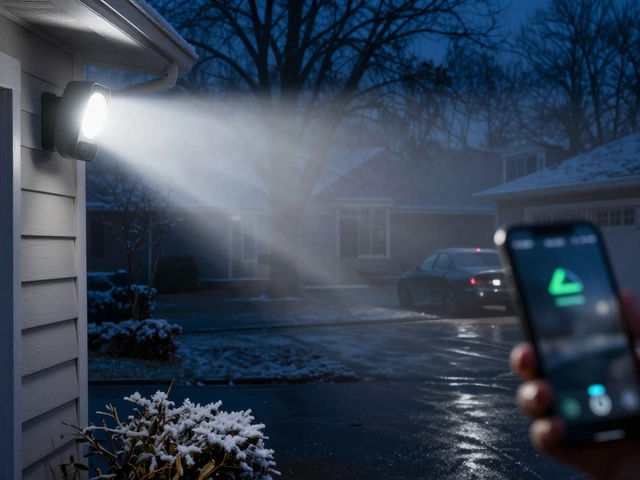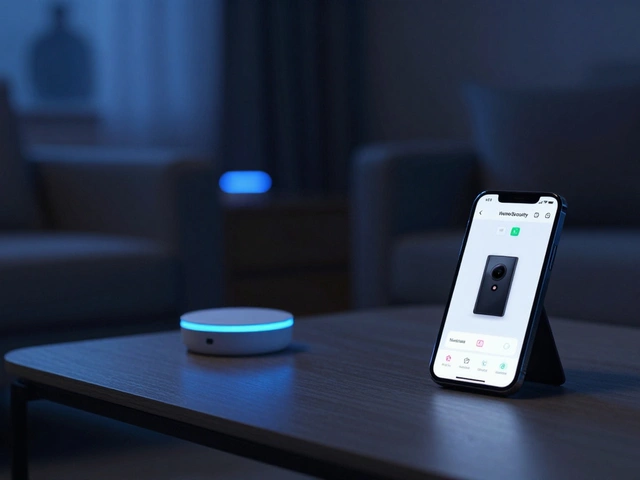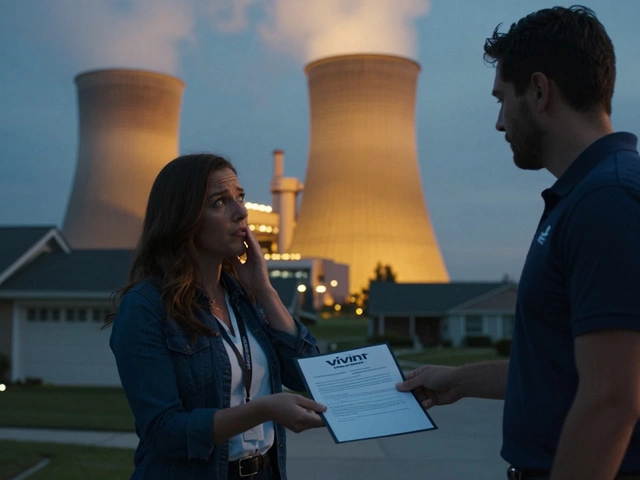You’re probably wondering if setting up CCTV means another monthly bill for internet—especially when you’re already counting pennies for the cameras and installation. Here’s the short answer: it depends on what you want your system to do.
Not every CCTV setup needs internet, especially if your main goal is basic recording and playback. Old-school wired systems can run just fine without ever touching Wi-Fi. Just hook them up to a DVR or NVR, and you’re set. But if you want fancy features like checking your cameras while you’re on vacation or getting alerts on your phone, that’s when internet gets involved.
Plenty of folks—myself included—prefer the no-internet setup for their grandma’s house or places where Wi-Fi is spotty. Still, if you’re like my son Nolan, who checks the doorbell from his phone every five minutes, you’ll want at least some connection. Each choice changes the cost, hassle, and risk factors in very real ways.
- Can CCTV Work Without Internet?
- Types of CCTV Systems and Internet Needs
- Remote Viewing and Mobile Alerts
- Cost Differences: Internet vs Non-Internet Setups
- Essential Tips Before Buying
- Common Questions Answered
Can CCTV Work Without Internet?
This is where things get interesting. Lots of people think all CCTV cameras are useless without Wi-Fi, but that’s not true at all. Standard wired CCTV systems, the kind you see in most older shops and homes, run totally independent from the internet. The cameras connect with cables straight to a DVR (Digital Video Recorder) or NVR (Network Video Recorder), which saves the footage locally—usually to a hard drive.
Here's the basic setup:
- Cameras run coaxial or Ethernet cables to a recording box (DVR/NVR)
- The recorder stores video to a built-in hard drive
- You view footage on a monitor connected directly to the recorder
No streaming, no cloud, no data chewing up your bandwidth. The only time you’d ever need the internet is if you wanted remote access, meaning to view footage when you’re not on-site. Even then, the main recording keeps working if the internet goes out—so burglars can't just unplug your Wi-Fi and sneak by.
Lots of businesses actually prefer this. In fact, a 2022 survey of small business owners in the UK showed that over 60% still use local-only CCTV setups because they’re less likely to have footage hacked or interrupted when the internet drops. Even some hospitals and schools intentionally keep their security cameras off public networks for better privacy.
| System Type | Needs Internet? | Main Storage | Remote Viewing? |
|---|---|---|---|
| Traditional Wired CCTV | No | DVR/NVR (Hard Drive) | Only with network |
| Wi-Fi (Wireless) Cameras | Usually Yes | Cloud/MicroSD | Yes |
| Hybrid Systems | Optional | Local + Cloud | Optional |
If your goal is basic security—like watching entrances, deterring package thieves, or checking the backyard—an internet-free system saves money up front and over time. No internet means you skip cloud storage fees and don’t need to pay for better Wi-Fi or Ethernet. Just remember, you won’t get phone alerts or remote access unless you hook up the network cable.
Types of CCTV Systems and Internet Needs
You don’t need to be a tech geek to pick the right CCTV system, but you'll want to know what’s out there before spending your money. Let’s break down the main types and see how the internet fits into each one.
- Wired Analog Cameras: These are the classic setups—think of cameras plugged straight into a DVR (digital video recorder) with coaxial cables. No internet needed unless you want to view footage remotely. Just local storage, simple and direct.
- Wired IP Cameras: These use network cables (Ethernet/PoE). They connect to an NVR (network video recorder). Again, you don’t need internet for the cameras to record or playback locally, but you do need a local network. Internet only matters for outside access or cloud features.
- Wireless CCTV Cameras (Wi-Fi): These hook up over your Wi-Fi and send footage to a storage device or the cloud. Most require internet for setup, daily use, and especially remote viewing. Some have microSD cards, but accessing them safely and getting features like alerts is way smoother online.
- Battery-powered/Standalone Cameras: Think of cameras like the battery Ring cams or Arlo. These won’t work their magic (live viewing, cloud storage, smart alerts) without internet. Pop in a memory card and you can sometimes get by, but most features go away offline.
CCTV systems come in all shapes and sizes, but the internet part mostly depends on what you want after the cameras are up. If all you want is to record video and check later using a monitor, even a basic wired analog system works. But if you want to see that delivery guy in real time on your phone, that’s solidly in the internet-needed camp.
Here’s a quick comparison to give you a feel for what’s standard with each system type:
| System Type | Needs Internet? | Local Storage | Remote Access | Setup Cost Range (2025 USD) |
|---|---|---|---|---|
| Wired Analog | No* | Yes (DVR) | Optional (with internet) | $300 - $1,000 |
| Wired IP | No* | Yes (NVR) | Optional (with internet) | $500 - $2,000 |
| Wi-Fi Wireless | Yes/Strongly recommended | Sometimes (SD/NVR) | Yes | $100 - $800 per camera |
| Battery Standalone | Yes/Strongly recommended | Sometimes (SD) | Yes | $80 - $300 per camera |
*Some wired setups can use internet for extra features, but don’t require it to work. If you need to run a security setup somewhere totally off-grid—like a shed or remote workshop—wired analog is often the easiest budget pick.
Remote Viewing and Mobile Alerts
If you want to check your cameras from your phone or get buzzed when someone walks up your driveway, you’ll need an internet connection. This is the part that takes CCTV from just recording stuff to actually letting you see what’s going on—no matter where you are.
Here’s how it really works: your cameras connect to your home network (Wi-Fi or wired), then send the video data through your internet connection to an app on your phone, tablet, or computer. Most modern systems include their own free apps for this, and setup usually means just scanning a QR code or entering a device ID.
- Remote Playback: Not just live viewing—you can scroll back and see old footage from anywhere once your cameras are online.
- Push Alerts: Get notifications when someone enters the frame, or if the system detects motion at odd hours (hello, peace of mind).
- Sharing Access: Got family or team members needing access? The app lets you grant limited or full viewing rights.
But here’s a catch: live streaming and remote playback use data. If you have limited internet speed or a capped data plan, streaming several cameras in HD might gobble up a lot of bandwidth fast. According to a 2024 consumer survey, a single camera set to 1080p live view can use up to 60GB of data a month if streamed for just 2 hours a day. Multiple cameras or 4K service will use even more. Here’s a quick look:
| Video Quality | Daily Streaming (2 Hrs) | Monthly Data Usage |
|---|---|---|
| 720p | ~1.5GB/day | ~45GB/month |
| 1080p | ~2GB/day | ~60GB/month |
| 4K | ~8GB/day | ~240GB/month |
If you want mobile alerts but don’t check live streams often, set your cameras to send snapshots instead of video. This keeps data use low and still gives you a heads-up about anything weird going on.
A quick heads-up: Not all systems support cloud recording for free. Some big-name brands (like Ring and Arlo) charge for cloud storage—usually $3 to $10 per camera, per month. If you’re budget-minded, look for systems with free local storage or free cloud tiers.

Cost Differences: Internet vs Non-Internet Setups
The first thing most people ask about CCTV is how much it’ll cost to get cameras up and running—especially when it comes to internet setup. Here’s the thing: while both internet-connected and non-internet CCTV systems help you keep an eye on things, their price tags can look a lot different.
Non-internet (offline) CCTV systems are usually the go-to for anyone who wants basic local recording. They need a few essentials:
- Cameras (analog or digital)
- Cables for power and video
- A DVR (for analog) or NVR (for digital/IP cameras) to save footage
- Storage drive (often a standard hard drive)
The biggest cost here is often the labor: running physical cables through your walls isn’t usually a simple DIY job, unless you really love crawling through attics. But once it’s installed, there are no monthly fees. Everything is local. If you change nothing, your costs stop right there.
With internet-connected CCTV, the camera’s price usually jumps—especially for wireless models with smart features. There are extra costs that can sneak up on you:
- Subscription for cloud storage (around $3 – $10 per camera each month for popular brands)
- Upgraded home internet plan if you have lots of high-res cameras streaming continuously
- Occasional support or app upgrades over time
This table gives a real sense of what you’re looking at for a basic home system (rough average costs, as of early 2025):
| System Type | Initial Hardware/Installation | Monthly Subscription | Total Year 1 |
|---|---|---|---|
| Non-Internet (4 Cameras, DVR) | $400 – $800 | $0 | $400 – $800 |
| Internet-Connected (4 Wireless Cameras, Cloud Storage) | $600 – $1,200 | $12 – $40 | $744 – $1,680 |
If you want remote access, DIY internet cameras (like Ring, Arlo, or Eufy) can be easier to set up, but you’ll probably get hit by those monthly cloud fees. For big homes or businesses, even a small difference in monthly charges stacks up fast—just ask anyone with more than four cameras and a busy network.
Final tip: Always check if your camera system has an option for local backup (like a memory card or NAS device) and if you can skip subscriptions. For many, a mix of both types—wired for the serious spots and one smart cam for your main entrance—keeps costs lower without losing out on features you actually use.
Essential Tips Before Buying
Shopping for CCTV? Don’t just grab the first box that promises night vision and call it a day. There are a few things you should work out first, or you might end up spending more than you planned—or worse, buying something that doesn’t do what you want.
- CCTV systems come in a dizzying number of options: wired, wireless, cloud, local storage, 2MP, 8MP, PoE, you name it. Decide if you mainly want to review footage later (in which case internet’s not needed), or if you want live alerts on your phone, which requires a reliable internet connection.
- Check the camera’s resolution. 1080p is plenty for most homes. But if you want to read license plates or spot faces from far away, you may want to go 4K. More resolution usually means bigger storage and a higher price tag, though.
- Think about storage. Most DVR/NVR systems with hard drives can run 24/7 for weeks. Cloud storage monthly fees add up quick. Here’s a quick breakdown:
| Storage Type | One-Time Cost | Monthly Fee | Typical Storage Period |
|---|---|---|---|
| Local DVR/NVR (1TB) | $60-$120 | $0 | 2-4 weeks |
| Cloud (per camera) | $0-$20 | $5-$30 | 7-30 days |
- Power is a hidden cost. Do you want to bother with battery changes (wireless cams drain quicker than you’d think), or do you want a solid connection to your home’s power? Wireless may look easy, but it can mean running out to swap batteries every couple months, especially in cold climates. My daughter Avery practically turned battery swaps into a weekly chore last winter.
- Don’t ignore installation. Wired cams are usually cheaper to run long-term, but the upfront installation might require a pro—especially if you don’t love crawling through attics. Wireless is easier to set up, but can struggle with Wi-Fi dead zones or signal drop-offs.
- Keep an eye out for extra features you’ll actually use. Stuff like night vision, audio recording, pan-and-tilt, or floodlights all sound great—until you realize some features bump up the installation cost or even break privacy rules in certain areas.
Finally, always compare warranty periods and find out if tech support is local or only via email. If something breaks, the last thing you want is to wait weeks for a reply. And if your cameras connect to the internet, keep firmware updated—outdated systems are a magnet for hackers.
Common Questions Answered
People ask me all the time about the nitty-gritty details when picking a CCTV system. Here are some of the hottest questions—straight answers, no fluff.
Do I need internet for CCTV to record footage? No, not always. Classic wired CCTV can record straight to a DVR or NVR with zero internet required. You can still play back the footage on-site by plugging in a monitor, perfect for small businesses or homes that don’t care about remote access.
Will internet make my camera system safer? Not really. Having internet allows for remote viewing and alerts, but it can also introduce hacking risks if you don’t set strong passwords or update firmware. Some folks go totally offline for this reason, especially in rural or high-security spots.
Can I watch live CCTV on my phone without the internet? Unfortunately, no. If your system isn’t hooked up to Wi-Fi or a network, live remote viewing is off the table. You’ll have to check footage locally, either from the base station or by pulling the hard drive.
Does adding internet cost more? Most of the time, yes. You might need a faster plan, a better router, or wired connections to your cameras. Plus, some brands charge a few bucks a month for cloud backup or extra phone features.
Where do most people mess up with DIY installs? The biggest traps: not planning for cable runs on wired systems, letting internet cams run on default (easy-to-hack) passwords, or buying a cheap system that needs the cloud just to work. Read the manual—seriously. It saves headaches.
- If you want local recording only, skip the Wi-Fi and save money.
- For phone notifications, spend a little more and get a reliable internet plan.
- Always secure your system—rename any admin accounts and use strong passwords.
Getting the right CCTV system comes down to your needs, the layout of your place, and how much you want to spend. There’s no one-size-fits-all answer, but with these facts, you’ll avoid the most common mistakes—and maybe even save yourself a few bucks.






